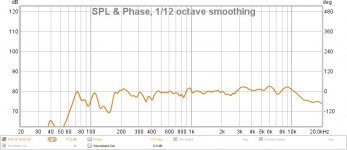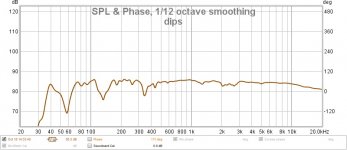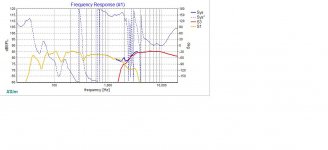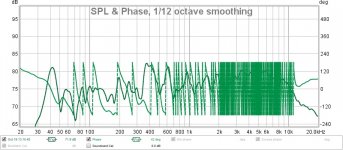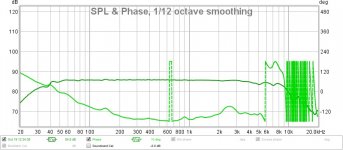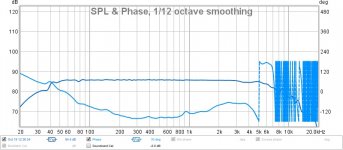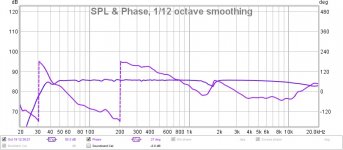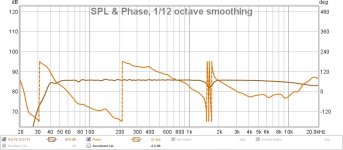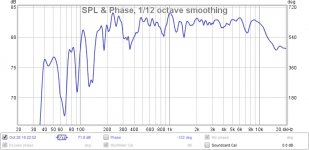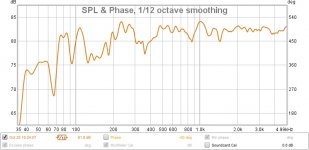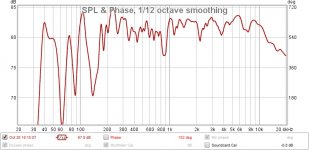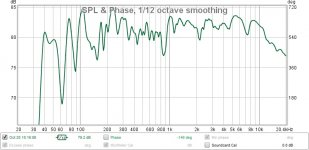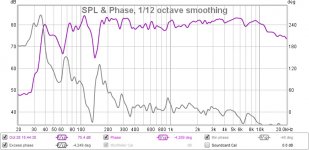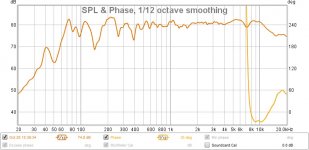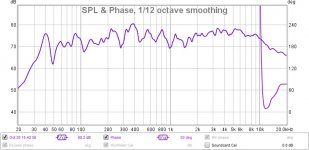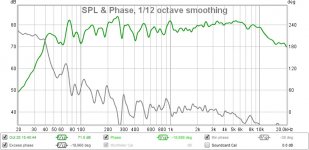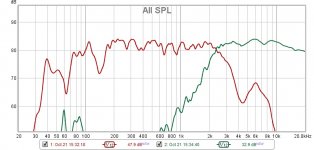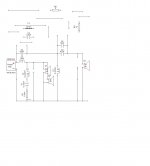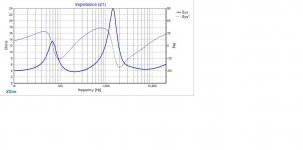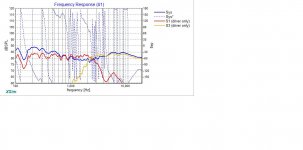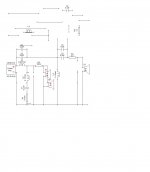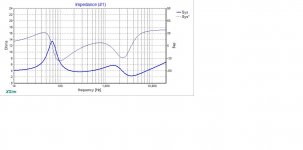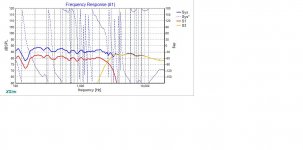Trying to reuse the small thor box/crossover and tweeters for the Nextel drivers as the mag drivers will not work in my environment. pulled the 2 resistors and 2.2 cap out from the tweeter side of the crossover one at a time after listening and measurement to get a relatively flat response. Using x sim I do not see a way to improve the crossover changing adding and subtracting moving components does not seem to help. the 10k to 20k rolls off some but the dips in the midrange and lows are more troublesome I have moved the speaker to several different positions with and without the port in place. so my question is are the boxes just wrong. is the crossover that far off? pull one woofer? (nextels are more efficient) and that would certainly make the port larger. not sure what to do next. winsid calls for a much smaller box. 38lt just over 1/2 the size of the small thor. I have loaded the drivers into the xsim but cannot get anything I add, subtract or change to improve the dips without totally changing the FR. any help or direction would be appreciated.
Attachments
Last edited:
thank you - i will look and try to move the speaker to a place that will not reflect as easily 70cm looks like it could be the equipment stand near the speaker. thank you again I spent the last couple of days reading trying the figure out how to get those dips out of the crossover and looking for a box design that may flatten the response. I am reading a speaker building book by Steven Weems but I am struggling to find crossover solutions for narrow peaks. thank you
The depressions in the low frequencies are not caused by the crossover. What you are seeing is the effect of the room response, which heavily impacts LF behaviour. This is why bass response must either be measured in a [large] anechoic chamber / equivalent thereof, or nearfield, then spliced into / merged with the rest of the response range, if all you wish to see is the loudspeaker's innate behaviour.
I think you should experiment with an EQ to get the balance right first.
To my eyes, the tweeter is about 2 dB too hot, but it's hard to tell since your measurements don't seem to be consistent.
The other issue is the cresting and evidence of proper phase matching.
That is, on one chart it seems the speaker crests in the middle of the audible range. If that is how it sound, you should adjust to have it crest closer to 100-500 Hz.
To my eyes, the tweeter is about 2 dB too hot, but it's hard to tell since your measurements don't seem to be consistent.
The other issue is the cresting and evidence of proper phase matching.
That is, on one chart it seems the speaker crests in the middle of the audible range. If that is how it sound, you should adjust to have it crest closer to 100-500 Hz.
Hi thank you for your help.
Here are measurements from approx. 6 inches away from each driver. the speakers would look funny as headphones. once I get a little farther away with the mic things start getting bad I will have to do more homework on the phase aspect it is all over the place. Does the flat response in the very near field mean the crossover and drivers are working as they should? And, the room or the phase is causing the erratic FR. As much as I love the small thor cabinets they may be too much cabinet for these drivers.
I have tried no port , blocked port and long port but the differences are not changing the low end very much.
I do not want to be confusing the chart that shows the higher tweet was xsim after I reentered the tweeter and the two woofers together from rew data I was trying to figure out is I could make changes to the crossover to impact the small severe dips and the tweeter fall off.
After moving the speakers all over the room the last chart shows the best of for the low end but it is by no means looking good. At this point the sound is not terrible but not what it was. the detail is not the same and the soundstage is less. not much happening outside of the boxes in between is ok
thank you again for the help
Here are measurements from approx. 6 inches away from each driver. the speakers would look funny as headphones. once I get a little farther away with the mic things start getting bad I will have to do more homework on the phase aspect it is all over the place. Does the flat response in the very near field mean the crossover and drivers are working as they should? And, the room or the phase is causing the erratic FR. As much as I love the small thor cabinets they may be too much cabinet for these drivers.
I have tried no port , blocked port and long port but the differences are not changing the low end very much.
I do not want to be confusing the chart that shows the higher tweet was xsim after I reentered the tweeter and the two woofers together from rew data I was trying to figure out is I could make changes to the crossover to impact the small severe dips and the tweeter fall off.
After moving the speakers all over the room the last chart shows the best of for the low end but it is by no means looking good. At this point the sound is not terrible but not what it was. the detail is not the same and the soundstage is less. not much happening outside of the boxes in between is ok
thank you again for the help
Attachments
Last edited:
As it is you are kind of sort of doing a quasi anechoic, so either commit to quasi-anechoic and do it exactly right, OR do everything at 1m on tweeter axis.
For 2 way speakers, the latter is as good, especially if you can blend gated with non-gated measurements. You get the in-room response and enough accurate data to measure the driver crossover range correctly.
For 2 way speakers, the latter is as good, especially if you can blend gated with non-gated measurements. You get the in-room response and enough accurate data to measure the driver crossover range correctly.
one meter measure port and no port.
thank you I will read up on the correct measurement methods. There is so much to learn. The one meter measurements are not great maybe the room is too small. they have large dips at 60 ,90 and 140 and the right speaker has 6db less deep bass. both speakers roll of about 6db from 10000 to 20000.
With the super near measurements I was trying to see if the speakers and other components were all working correctly and I am not sure if it telling me anything about the crossover. I guess the breakup modes are well controlled.
Attached are one meter measurements with and without the port in the speaker. I think the enclosure or the room may be the biggest opportunity for improvement?
Is there a way to get rid of the smaller dips and peaks in the higher mids and highs or is that just inherent in the drivers?
Is the rolloff of the tweeter fixable or is that just a product of the more sensitive woofers? or is it desirable with no baffle adjustment in the crossover?
Scottmoose's small thors were magical with the mag drivers. would like to get these close to that. Am I correct to leave the crossover for now and focus on the enclosure and the room? thank you again for your help.
thank you I will read up on the correct measurement methods. There is so much to learn. The one meter measurements are not great maybe the room is too small. they have large dips at 60 ,90 and 140 and the right speaker has 6db less deep bass. both speakers roll of about 6db from 10000 to 20000.
With the super near measurements I was trying to see if the speakers and other components were all working correctly and I am not sure if it telling me anything about the crossover. I guess the breakup modes are well controlled.
Attached are one meter measurements with and without the port in the speaker. I think the enclosure or the room may be the biggest opportunity for improvement?
Is there a way to get rid of the smaller dips and peaks in the higher mids and highs or is that just inherent in the drivers?
Is the rolloff of the tweeter fixable or is that just a product of the more sensitive woofers? or is it desirable with no baffle adjustment in the crossover?
Scottmoose's small thors were magical with the mag drivers. would like to get these close to that. Am I correct to leave the crossover for now and focus on the enclosure and the room? thank you again for your help.
Attachments
Don't worry about the bass just yet. Assume it is flat. When you listen you can find a place in the room for it. Later you can measure and add subs. For now you just want to see if you want to compensate the baffle, where and how much, not worrying about the bumps.
When you clear space around the speaker to measure, that space sets the lowest frequency you can deal with in that measurement. It may be in the hundreds of Hz.
When you clear space around the speaker to measure, that space sets the lowest frequency you can deal with in that measurement. It may be in the hundreds of Hz.
bass response must either be measured in a [large] anechoic chamber / equivalent thereof, or nearfield, then spliced into / merged with the rest of the response range, if all you wish to see is the loudspeaker's innate behaviour.
thank you I understand. At one meter if everything below 200hz is removed the response is choppy but relatively flat. the tweeter is inverted. and the top octave still rolls off. not sure how to improve the choppiness. I measured at the listening position and included those charts also. thanks again
Attachments
Last edited:
Don't worry about the chop.
Your system is pointing the wrong way. You want it to descend from around 100-200 Hz. See the B&K curve:
bruel & kjaer optimum curve For hifi - Members Albums Category - The Klipsch Audio Community
It also seems like you will need to EQ the tweeter a little to get you the last octave.
Measure the drivers individually at 1m and import into XSim. If you don't know how to measure relative speaker distance, that will be needed as well. Once there, rethink your crossover.
Your system is pointing the wrong way. You want it to descend from around 100-200 Hz. See the B&K curve:
bruel & kjaer optimum curve For hifi - Members Albums Category - The Klipsch Audio Community
It also seems like you will need to EQ the tweeter a little to get you the last octave.
Measure the drivers individually at 1m and import into XSim. If you don't know how to measure relative speaker distance, that will be needed as well. Once there, rethink your crossover.
here is the measurements with one woof one tweet and in x sim. I included the spl for the two speakers combined maybe I should just leave on woof disconnected.
Attachments
ok running through xsim with the actual drivers a few small adjustments to the crossover and I think the slope is more like you showed me. what do you think?
Attachments
I use holmimpulse to measure. You cut (gate) the result to remove the reflections. The highs come out clean and the lows become limited accordingly. This makes sense, where smoothing wouldn't.
- Status
- This old topic is closed. If you want to reopen this topic, contact a moderator using the "Report Post" button.
- Home
- Loudspeakers
- Multi-Way
- Box port or crossover dippity do
